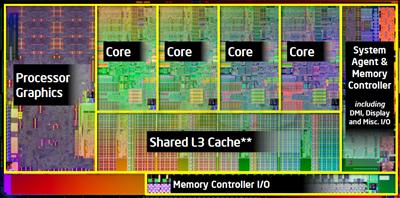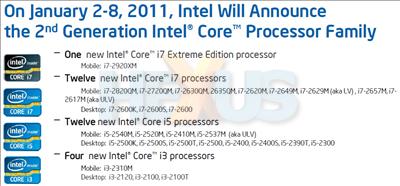Intel has today taken the wraps off of its eagerly-anticipated range of 2011 Sandy Bridge processors.
The line up, consisting of a mammoth 29 launch models across desktop and mobile platforms, has been officially dubbed the "2nd Generation Intel Core Processor Family" and promises "breakthrough" performance based on a new 32nm microarchitecture.

Continuing to utilise the established Core i3, Core i5 and Core i7 brands, the new parts may outwardly appear to be a small step up from previous-generation Nehalem and Westmere, but there's more to these new chips than meets the eye.
Sandy Bridge - what's new?
Arguably the most significant development is that the second-generation Core processor family is the first to integrate a CPU, a memory controller and a graphics processor onto a single piece of silicon.
The integration brings with it various benefits, including a smaller package that will allow for thinner computer systems and improved performance through tight links between its individual parts. The L3 cache serves both the CPU and GPU, and in order to maintain bandwidth and low latencies, Intel has implemented a ring-based interconnect that lets the multiple processors tap into the cache efficiently.
Furthermore, whilst all parts are tightly connected, each has independently evolved along the way. Sandy Bridge processors come armed with Turbo Boost 2.0, a new-and-improved implementation of Intel's dynamic scaling technology that will exceed the chip's rated TDP to provide higher automatic overclocks to the CPU's cores for a shorter period of time. Ideal for quick-burst scenarios such as loading applications.
But there's a catch. The changes to the architecture come accompanied with a change of socket. Packaged as LGA1155, Sandy Bridge processors won't slot into previous-generation motherboards, making this potential upgrade more challenging than we'd like.
A new age of integrated Intel graphics?
In addition to the CPU enhancements, the on-die GPU has also been given a major overhaul. Though integrated solutions have traditionally disappointed, Intel claims Sandy Bridge will usher in "revolutionary new media capabilities".
Available in a choice of two flavours - Intel HD Graphics 2000 and Intel HD Graphics 3000 - the graphics processors feature six or 12 execution units, respectively, and each unit is itself revamped to offer significantly more performance than the previous generation.
The DX10-class chips will continue to offer limited gaming potential, but excels at numerous multimedia tasks. With enough power to facilitate hardware-accelerated encoding, decoding and transcoding, a media processing engine dubbed "Intel Quick Sync Video" can provide rapid high-def video conversions without a heavy burden on CPU cores. Support for HDMI 1.4 ensures Blu-ray 3D compatibility, and Intel Wireless Display (WiDi) has also been bumped up to full-HD 1080p.
The 2nd Generation Intel Core Processor Family
Digging through Intel's 29 new products isn't easy, but the entire haul can be split into easier-to-digest categories. Of the first 29 parts, 15 are mobile and 14 target the mid-range desktop and are split across the Core i3, Core i5 and Core i7 brands:
That's still a lot to take in, but here are the important bits. New Sandy Bridge processors are given a four-figure numerical model number, as opposed to three on previous Nehalem/Westmere parts. The leading "2" represents the second-gen family, and the higher the number after that, the better the performance.
The following table covers the eight main desktop SKUs, and we've added a few current-gen alternatives for comparison's sake.
| Model | Cores / Threads | Clock (GHz) | Turbo (Max) | Process | L3 Cache | Graphics | Graphics clock | Memory support | TDP | Socket | Price (1Ku) |
|---|---|---|---|---|---|---|---|---|---|---|---|
| Core i3 2100 | 2/4 | 3.10 | N/A | 32nm | 3MB | HD 2000 | 1,100MHz | Dual-channel | 65W | LGA1155 | $117 |
| Core i3 2120 | 2/4 | 3.30 | N/A | 32nm | 3MB | HD 2000 | 1,100MHz | Dual-channel | 65W | LGA1155 | $138 |
| Core i5 2300 | 4/4 | 2.80 | 3.10 | 32nm | 6MB | HD 2000 | 1,100MHz | Dual-channel | 95W | LGA1155 | $177 |
| Core i5 2400 | 4/4 | 3.10 | 3.40 | 32nm | 6MB | HD 2000 | 1,100MHz | Dual-channel | 95W | LGA1155 | $184 |
| Core i5 2500 | 4/4 | 3.30 | 3.70 | 32nm | 6MB | HD 2000 | 1,100MHz | Dual-channel | 95W | LGA1155 | $205 |
| Core i5 2500K | 4/4 | 3.30 | 3.70 | 32nm | 6MB | HD 3000 | 1,100MHz | Dual-channel | 95W | LGA1155 | $216 |
| Core i7 2600 | 4/8 | 3.40 | 3.80 | 32nm | 8MB | HD 2000 | 1,350MHz | Dual-channel | 95W | LGA1155 | $294 |
| Core i7 2600K | 4/8 | 3.40 | 3.80 | 32nm | 8MB | HD 3000 | 1,350MHz | Dual-channel | 95W | LGA1155 | $317 |
| Core i5 661 | 2/4 | 3.33 | 3.60 | 32nm | 4MB | HD 1000 | 900MHz | Dual-channel | 87W | LGA1156 | $196 |
| Core i5 760 | 4/4 | 2.80 | 3.33 | 45nm | 8MB | N/A | NA | Dual-channel | 95W | LGA1156 | $206 |
| Core i7 875K | 4/8 | 2.93 | 3.60 | 45nm | 8MB | N/A | N/A | Dual-channel | 95W | LGA1156 | $342 |
| Core i7 930 | 4/8 | 2.80 | 3.06 | 45nm | 8MB | NA | N/A | Triple-channel | 130W | LGA1366 | $294 |
| Core i7 950 | 4/8 | 3.06 | 3.33 | 45nm | 8MB | NA | N/A | Triple-channel | 130W | LGA1366 | $294 |
| Core i7 980X | 6/12 | 3.33 | 3.60 | 32nm | 12MB | NA | N/A | Triple-channel | 130W | LGA1366 | $885 |
As the table suggests, second-generation Core i3 chips are dual-core, hyper-threaded processors without Turbo Boost. Core i5 parts offer four physical cores with turbo boost, and Core i7 serves up the full shebang; quad-core, hyper-threading, turbo boost and a large 8MB L3 cache.
Then there's the two K-series processors. Being the leaders of their respective packs, Intel offers them in a multiplier-unlocked form, much like AMD's Black Edition CPUs. Designed for the enthusiast in mind they ship with full-fat HD 3000 graphics, meaning practically double the IGP power.
Is Intel's new microarchitecture able to provide the expected bump in performance? Is Sandy Bridge the best choice for your next machine? We'll have all the answers in the upcoming HEXUS review.

















